Health Concerns
- Home
- Health Concerns
- Ear Infection
What kind of disease is a middle ear infection?

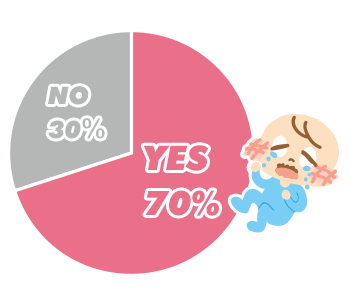
What are the symptoms of a middle ear infection?

What are the causes of a middle ear infection?
Is a middle ear infection a recurrent disease?
→Please refer to“Why are young children susceptible to middle ear infections?” for more details
A recurrent middle ear infection is tough not only on the child, but on the parent! Multiple visits to a doctor’s office can become troublesome and costly, and taking care of a sick child at home is tough.
Possible causes of recurrent middle ear infections in young children:
1. Immature immune systems
2. Infected with antibiotic-resistance bacteria (bacteria resistant to certain types of antibiotics)
3. Environment (nurseries, proximity to cigarette smoke, etc.)
Very young children (less than 12 months old) with immature immune systems are particularly susceptible to a recurrent middle ear infection.
What types of middle ear infections are there?
Acute Middle Ear Infection
| Degree of Risk |  |
| Symptoms | Symptoms can include severe ear pain, fever, and discharge from the ear. |
| Causes | Both bacteria and viruses can cause an infection in the middle ear. |
| Treatment Period | Once a course of antibiotics is started, it can take up to 10 days to resolve the infection. |
| Cautions | Identifying a middle ear infection in infants can be difficult, as children not old enough to talk can’t describe their symptoms. Signs to look out for include: a fever of unknown origin, frequently touching or pulls on the ear, has trouble falling asleep, or if tapping the back of the head behind the ear causes pain or makes your child cry. Left untreated, there is a chance that it will lead to a recurrent middle ear infection, a middle ear infection with effusion, or a chronic middle ear infection. You need to pay a careful attention from the beginning. In some cases, discharge from the ear may reduce pain and fever and relieve the condition, however leaving the infection until this level may cause the infection to be chronic. Seeking early treatment is highly recommended! |
Middle Ear Infection With Effusion
| Degree of Risk |  |
| Symptoms | A middle ear infection with effusion is when fluid builds up in the middle ear. It causes hearing problems but does not usually cause pain or fever. |
| Causes | Most cases are caused by an extended initial episode of acute middle ear infection. |
| Treatment Period | A full recovery will likely take at least one month, and could take up to few years if the infection is protracted. |
| Cautions | Identifying a middle ear infection in infants can be difficult, as children not old enough to talk can’t describe their symptoms. Signs to look out for include: a fever of unknown origin, frequently touching or pulls on the ear, has trouble falling asleep, or if tapping the back of the head behind the ear causes pain or makes your child cry. Left untreated, there is a chance that it will lead to a recurrent middle ear infection, a middle ear infection with effusion, or a chronic middle ear infection. You need to pay a careful attention from the beginning. In some cases, discharge from the ear may reduce pain and fever and relieve the condition, however leaving the infection until this level may cause the infection to be chronic. Seeking early treatment is highly recommended! |
Chronic Middle Ear Infection (Chronic Otitis Media)
| Degree of Risk |  |
| Symptoms | Symptoms include discharge from the ear, hearing problems, ringing in the ear and dizziness as a result of a perforated eardrum. |
| Causes | In some cases, if antibiotics are ineffective, an acute middle ear infection can become chronic. |
| Treatment Period | Human ears have a natural cleaning function to push out bacteria. If an inflammation occurs in the middle ear, the body tries to heal the inflammation by bursting the eardrum and pushing the pus out through it. |
| Cautions | Once the pus has been pushed out and drained from the ear, the inflammation subsides and the hole in the eardrum closes up naturally. However, if an acute middle ear infection is not treated properly or if the infection recurs, the hole may cease to close naturally. This is a state of chronic middle ear infection. |
Why young children are susceptible to middle ear infection?

Group children’s activities are an ideal place to contract an infection.
Children cannot blow their own noses well.
How can I treat a middle ear infection?
Treatment at Hospital
Since a middle ear infection is, in most cases, a bacterial inflammation, antibiotics are the most common treatment. Antibiotics can relieve the symptoms in 3 to 4 days and clear up the infection within approximately 10 days. If the infection persists beyond 10 days, your child may have been infected with antibiotic-resistance bacteria. Please consult with a doctor immediately.
Another common treatment is to use a nebulizer to spray medicinal solution through the nose to the inner nasal passages and throat. * Firstly, aspirate your child’s nose using a nasal aspirator, to reduce further infection. * Use a nebulizer to spray medicinal solution directly to the mucus membranes in the nose. This can help open the nasal passages to ease breathing. * Nasal aspiration is a treatment used at hospitals, but it is also important to aspirate your child’s blocked or runny nose at home in order to prevent future infections.
Depending on the condition of the middle ear infection, treatment may involve piercing the eardrum to drain the pus. It may sound drastic, but the hole of eardrum will heal itself within a couple of days. However, any surgery can be traumatic for your child, not to mention expensive, so prevention is always best. If you suspect your child has a middle ear infection, please consult a doctor immediately.
Treatment at Home
If your child gets a middle ear infection, the basic treatment is medication. However, nasal care at home is indispensable as a part of treatment. Lately, doctors recommend aspirating your child’s nose at home using commercially available nasal aspirators. As young infants have trouble blowing their noses effectively, a nasal aspirator can help remove bacteria from your child’s nose. This is very effective for preventing, or promoting early healing of, a middle ear infection. There are a variety of commercially available nasal aspirators in the market. While manually-operated mouth suction or bulb aspirators are a low cost option, electronic aspirators avoid all contact with mucus that is removed from your child’s nose, preventing any risk of the parent contracting the infection. There are also some electronic aspirators available on the market that have the same strength of suction as professional models used by ENT doctors. Functionality has been improved for home use, so nasal care at home is now easier than ever. Since variety of types of nasal aspirators are available and purchased through online retailers, select the one that fits in the best with your child!
Self-diagnosing a cured middle ear infection and ceasing treatment without consulting your doctor can be dangerous. Incomplete treatment may cause the infection to recur. It is important to continue with treatment until your doctor has determined that the infection is resolved.
How can I prevent a middle ear infection?

The most common cause of middle ear infection is a runny nose. A child’s runny nose is filled with many bacteria and viruses. Careful aspiration is important, particularly for children who face recurrent middle ear infections. Frequent aspiration using a home nasal aspirator is recommended.
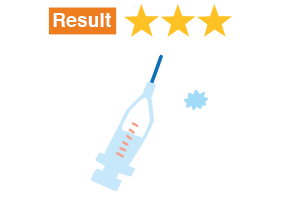
Pneumococcus is one of the pathogens that can cause a middle ear infection. Getting the pediatric pneumococcal vaccination may prevent a middle ear infection.
* Both the US and Europe acknowledge the preventative efficacy of the pediatric pneumococcal vaccine for middle ear infections. The vaccine reduces likelihood of middle ear infection by 7% in the US and 6% in Finland.
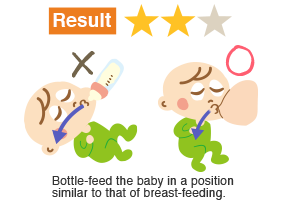
In some cases the position of bottle-feeding can cause a middle ear infection. When a baby is lying flat while bottle-feeding, milk can flow into the middle ear through the Eustachian tube and cause an infection. This can be prevented by angling your baby upward as much as possible to a position similar to that of breastfeeding. Burping your child after feedings can also help!

Tobacco smoke contains cyanide fume. Cyanide fume inhalation can cause a middle ear infection. Children with smoking parents have higher rates of middle ear infections. Please keep your child away from tobacco smoke!
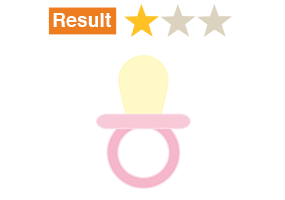
Children who use a pacifier longer for than 12 months have a higher chance of developing a middle ear infection. Sucking a pacifier can generate negative pressure in the spaces in baby’s throat and nose, and this affects the middle ear. Stop using a pacifier if the infection recurs many times or is protracted.
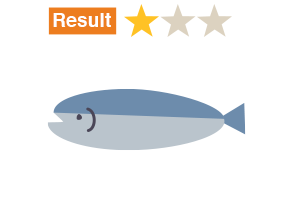
Pay attention to what your child eats. Vegetables, fruit and seafood improve the immune system. Vegetables and fruits contain a wide range of nutrients that can help fight infection, and seafood contains Omega 3, which boosts the immune system. Wild salmon in particular contains a high level of Omega 3, and is safe for children to eat.

Dust and environmental allergens can exacerbate nasal congestion, which causes swelling and clogs the Eustachian tube. Try to keep your child’s bedroom free from dust by cleaning it regularly.
Is it safe to bathe a child with a middle ear infection?
Is it safe to bathe a child with a middle ear infection?
Are some children more susceptible to middle ear infection than others?
Poor ventilatory or pressure-relief functions: Do you frequently have trouble equalizing pressure in your eardrums when at altitude, or when flying? If the pressure-relief functions of your ears are weak, you may have passed this on to your child.
Weak lymphoid tissues such as tonsils or adenoid: Do your colds regularly cause swelling in your tonsils, or develop into tonsillitis?
You have allergic rhinitis: Are you sensitive to pollen and dust to the point where it makes you sneeze constantly?
I can’t get rid of my child’s middle ear infection.
What if my child gets a middle ear infection in the middle of the night?

→ Cool the ear with a cold compress. Make sure to wrap around and cover the ear to cool.
→ Dispense children’s aspirin.
These methods may help relieve the pain to help your child sleep, but be sure to visit an ENT doctor in the morning.
